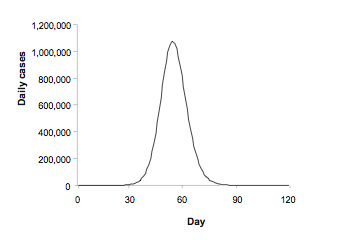Continuity Forum urges organisations not to be complacent
5th May 2009
Swine Flu, or A(H1N1) as the World Health Organisation would prefer it called continues to dominate the news media internationally, with nearly 1100 cases in 21 countries now reported with 27 fatalities.
Good reaction, planning and Tamiflu intervention appears to be working and the symptoms are being described as Mild. This appears to be good news and in the last few days accusations are being levelled of the whole Pandemic scenario being hyped out of all proportion.
Radio phone-in's and media commentators articles are suggesting an over reaction by WHO, governments and the media in the face of what they describe as a relatively 'minor' Health scare. Despite information from the World Health Organisation and health agencies urging against complacency, many people are starting to trivialise the threat posed despite the warnings being given.

Above is the predicted spread of an influenza Pandemic as developed by Professor Neil Ferguson and submitted to the House of Lords Science and Technology committee, which has responsibility for Pandemic Influenza.
As can be seen, the peak shows infections rising over time to over 1 million cases a day after about 7-8 weeks from the first UK infection. As with all modelling, it is an educated interpretation based on experience and analysis and Professor Ferguson's model may be incorrect or have errors that misrepresent the spread of infections (if it is, then so are many others that have been published), but look closely at the curve above.
We have had the A(H1N1) virus for just one week here in the UK; the government and HPA have done a sterling job, but one week in and the media are talking about the second phase potential. This is happening just four weeks BEFORE the research shows the rapid escalation of cases in the first phase model … we at the Continuity Forum think this is a little premature at least and potentially quite dangerous.
At the moment the instantaneous news media is giving immediate opinions on matters that need to be thoroughly understood. The epidemiology of A(H1N1) needs to be understood in much greater depth, and it is rash to dismiss this 'initial' stage of the current outbreak as over or under control just yet.
More needs to known about the source in Mexico and particularly the rate of fatalities that has not yet been seen elsewhere in the world. The death of 25 people from 590 cases suggest a Case Fatality Rate (CFR) of 4.24% which is much higher than Seasonal Flu and towards the upper levels of the worst case planning scenarios, yet in the US some 286 cases resulted in the death of one infant, a CFR of 0.35%.
Why is there such a huge difference?
Was it the source numbers underestimating the total number of cases in Mexico or was it something else?
Perhaps it is the early intervention with Anti-Virals given at the optimum time, stalling progression of the virus?
What ever the reason now is not the time to be suggesting the worst is over, and indirectly creating a sense of complacency in the minds of the general public and business.
The UK government is delivering advice to all homes urging vigilance and good hygiene protocols, trying to keep folks informed and aware of the potential risk of infection - and the simple steps required to mitigate them. This though is against a real mix of opinion in the general populace; some alert, informed and not unduly alarmed, but others dismissing it as Hype and overreaction!
Mexico will be returning to work tomorrow with shops, businesses, schools and restaurants all reopening. Hopefully the worst is past for them, but over the next few weeks we'll see what happens both in Mexico and the other countries as the Virus continues to develop.
Yes, we did say develop, as this is exactly what a virus does. It'll continue its evolution, changing and mutating, trying to find new ways to propagate itself. We are still at the the very earliest stages of this situation and our knowledge of it, and we should exercise caution in rushing to judgement.
Careful consideration of the potential impact and sensible measures addressing them should be developed to help your organisation, and importantly be rehearsed and communicated. Of course, the naysayers could turn out to be right and the threat may fizzle out, but what incredible folly would it be to do nothing when the window of opportunity exists to really bolster resilience and create the potential for far better continuity.
The Continuity Forum can help and advise your organisation please mail us here Pandemic Support
Any organisation requiring advice or support should contact us immediately, we are also holding a Continuity Forum Special Pandemic Summit on June 26th for more details follow the front page link or contact us directly. More information on pandemic research
We are changing our registration systems and if have yet to complete the new registration process please click on the link above.
For more details on our events, workshops and industry development work, as well as the general activities of the Continuity Forum please contact us directly on +44 208 993 1599 or mail us HERE! Please do contact Sara McKenna or Russell Price .

If you would like to know more about how your organisation can get involved and benefit from working with the Continuity Forum, please email us HERE! or call on + 44 (0) 208 993 1599.

